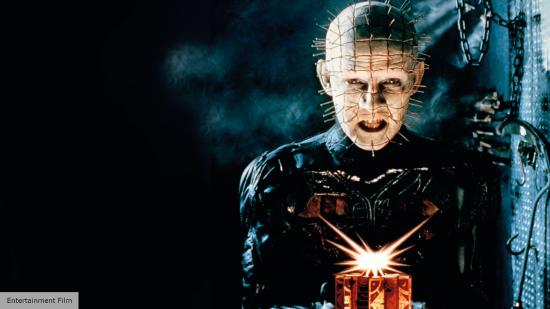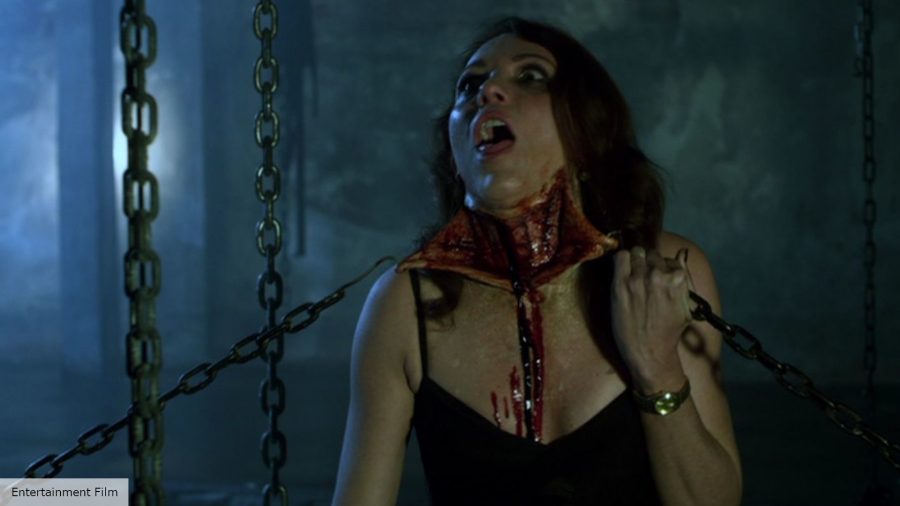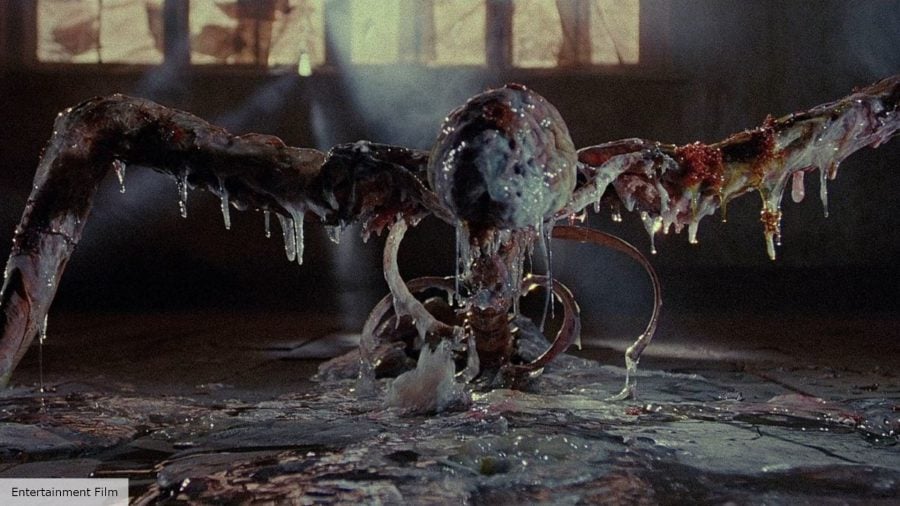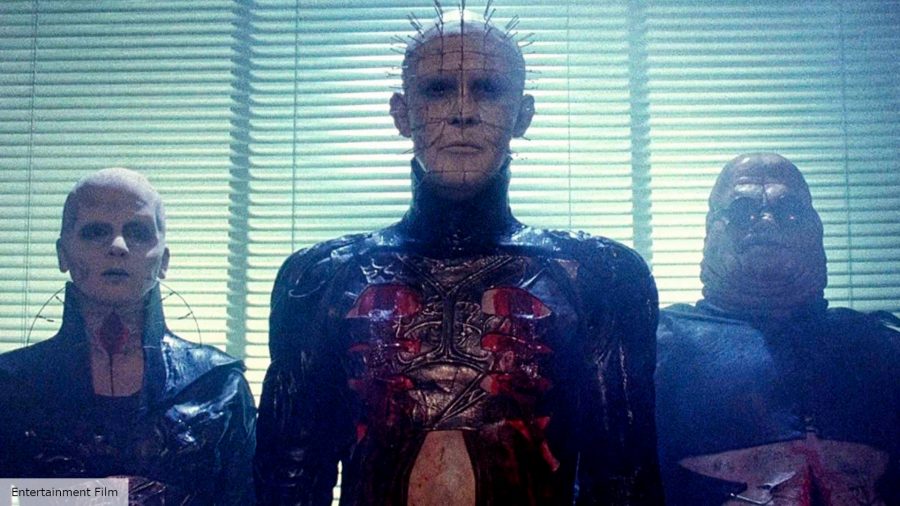In the ‘80s, Hellraiser took the horror world by storm, becoming a hit because of its social commentary and abstract, complex plot. But how did it develop into the unshakeable cult classic it is today? We explore its legacy below.
In the 20th century, horror movies were almost exclusively interested in the female form. In most films of its kind, it was inextricably linked to sex and death and reflected contemporary views on both phenomenons. Take the following description from Carol J. Clover’s book Men, Women, and Chainsaws as a case in point: “In the kitchen, he is silently dispatched by the killer, Michael (Myers, from Halloween), who then covers himself with a sheet (it is Halloween), dons Bob’s glasses, and goes upstairs. Supposing the bespectacled ghost in the doorway to be Bob, Lynda jokes, bares her breasts provocatively, and finally, in irritation at Bob’s stony silence, dials Laurie on the phone.” In other words: if you’re promiscuous, your days are numbered.
In 1987, Clive Barker decided to buck this trend with his directorial debut, Hellraiser. The film, which was based on his novella The Hellbound Heart, birthed one of the strangest and most unique franchises in horror. It’s partly influenced by the slasher sub-genre, which was popular around the time it was released, but whereas in those films sex and death are usually portrayed as a morality issue and separate things, in Hellraiser, there’s no difference between the two: pleasure and pain are intertwined.
The first character introduced to the audience is Frank Cotton, a man whose entire life is defined by the pursuit of pleasure. But that isn’t good enough for him: the only way he can get his rocks off – spiritually and physically – is by pushing his mind and body right to the edge, and then pulling them back moments before crunch time. It’s no surprise he’s drawn to the Lament Configuration, a strange puzzle box given to him by a mysterious man in Morocco who claims it’ll offer him pleasure like nothing else on Earth.
Mindbending puzzels: The best thriller movies
The box itself gives a race of extra-dimensional demonic-type beings, the Cenobites, access to Earth; beings who believe the purest form of pleasure is doling out pain. (“Explorers in the further regions of experience. Demons to some; angels to others,” as Pinhead describes himself and the other Cenobites).
But most of all, what Hellraiser is interested in is subversion, most notably of the horror genre’s treatment of its female characters as an extension of the male psyche. In horror movies women are either boyish in nature, like Halloween’s Laurie Strode (or, in fact, Hellraiser 3’s Joey Summerskill) or are a representation of the author’s sexual desire. They may dress in a more masculine way than the film in question’s other women and have names which are typically associated with men, or more commonly be sexually promiscuous and very willing to bare themselves in front of the film’s male character (and they are almost always male).
Not so with Joey. She’s certainly supposed to remind the audience of those other characters – that’s why her name is so masculine – but she doesn’t act anything like them. Much like the male figures in other horror films, she’s a career person, only concerned with getting to the root of a mystery (a common trope in Barker’s work: see Candyman).
Famous spirits: The best ghost movies
Instead of the women, men are the main focal point in the Hellraiser films, both as manifestations of horror (very few people will forget seeing Frank Cotton’s bloody, half-revived body) and sexual objects. In the first film, Julia cotton is both the antagonist and protagonist, inasmuch as the film is more about her sexual gratification than anyone else’s: she wants to bring Frank back from the dead in order to get the kind of pleasure she never will from Larry, her husband, and Frank’s brother. We see him through her eyes, as someone with a lot of sex appeal.
It’s a theme that only gets more prominent throughout the first three Hellraiser films. If the first was a subversion of the conventions of the genre itself, the subsequent ones reflect the themes number one go more deeply into the pro-LGBTQ+ themes which got their start in number one. Hellraiser 3: Hell on Earth, in particular, is primarily about the punk-inflected American BDSM scene, one which is famously open to LGBTQ+ folks. Although Doug Bradley, the actor who plays Pinhead, had long been considered a sex symbol by the release of the third film, Hell on Earth is the one that defined Hellraiser as one of the few popular LGBTQ+ horror franchises of the ‘80s and ‘90s.
There are few scenes in Hell on Earth which do not reference sex in some shape or form: The Boiler Room itself, the nightclub which one of the film’s antagonists, J.P. Monroe (more about him later) owns, is filled with sexual iconography: cages, raised platforms, chains, piercings, and it also has a uniquely Gothic sensibility. It’s inundated with flames, artificial fog, and strange, satanic motifs like children’s dolls nailed to planks of wood.
Deadly style: The best zombie movies
It’s no wonder the Cenobites choose the club as their battleground. This is further solidified by J.P. Monroe’s place in the film: rarely is he seen with no outfit on, and when he is, it’s usually one of BDSM chic – leather, tight-fitting tees, boots, all of which wouldn’t be out of place in his own nightclub.
But this isn’t only conjecture. Barker himself stated in an interview with the Guardian: “On S&M’s sliding scale, I’m probably a six. There was an underground club called Cellblock 28 in New York that had a very hard S&M night. No drink, no drugs, they played it very straight. It was the first time I ever saw people pierced for fun. It was the first time I saw blood spilt.” The austere atmosphere definitely informed Pinhead: “No tears, please. It’s a waste of good suffering!”
But this eroticism isn’t the only thing Hellraiser has going for it. If that were the case, it wouldn’t be as popular as it is. After all, there was seemingly a new erotic thriller coming out every week during the ‘80s and ‘90s. In fact, Hellraiser is about the conflict between a traditional, conservative view of America, and the free-spirited version that was phasing it out. That’s what the Cenobites represent above all else: a future which, no matter how you try to stave it back, will find a way to come back stronger.



